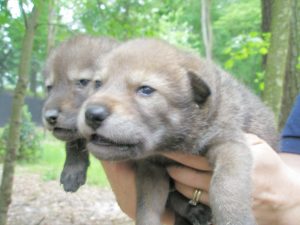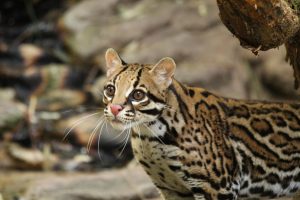The Salisbury Zoo’s Conservation Mission
The Salisbury Zoological Park is committed to enhancing our quality of life by providing a friendly, relaxing environment where educational and recreational opportunities come together through participation and interaction. With its animals, staff, volunteers and park-like setting, the Zoo encourages appreciation of wildlife and inspires conservation of our natural world.
North American Songbird Saving Animals From Extinction (SAFE) Program
Learn about this program and how you can help birds at home here.
Pollinator Gardens
The Salisbury Zoo has several pollinator gardens on site — the herb garden, Education beds, bee garden, bird garden, along the South American boardwalk and at the beds at the end of the boardwalk by the lynx.
The following plants can be found at the Zoo:
- Echinacea (also known as coneflower)
- Butterfly weed
- Common milkweed
- Mint
- Blue bonnet
- Black-eyed Susan
- Pepper plants
- Butterfly bush
- Wild poinsettia
- Sweet Joe-Pye-weed
- Goldenrod
- Ironweed
- Lupine
- Verbena
- Bee balm
- Phlox
MD Pollinators of Concern partnership
MD Pollinators of Concern is an initiative created by the department of biological sciences’ faculty and students at Salisbury University. Their research is focused on Maryland’s rare, endangered and threatened pollinators. They aim to create further awareness of these pollinators through partnerships like ours where they can conduct research and collect data of these pollinators while educating the public at the same time.
Students will use the Salisbury Zoo’s onsite pollinator exhibit to collect data to be logged onto its website. The pollinator exhibit is viewable to Zoo visitors and will display information about the pollinators and the research Salisbury University is doing.
The students and faculty of Salisbury University will educate the Zoo’s Education Department staff and docents so they are able to assist in spreading the information of Maryland Pollinators of Concern to zoo guests.
Want to help? Join scientists, naturalists and citizen scientists across the world by becoming an iNaturalist. Visit their site for more information and how to get involved.
Learn more
 The Zoo identifies conservation as a primary product. Within the boundaries of its financial resources, the Zoo recognizes that its principal mission-based outcomes will be achieved through its capacity to impact and influence its guests and its community. The Zoo will attempt to provide engaging, nature-based experiences that inspire caring attitudes. Through the caring attitudes of those guests, the Zoo will foster actions that embody a sense of stewardship for the living world and the achievement of outcomes that support the conservation of nature.
The Zoo identifies conservation as a primary product. Within the boundaries of its financial resources, the Zoo recognizes that its principal mission-based outcomes will be achieved through its capacity to impact and influence its guests and its community. The Zoo will attempt to provide engaging, nature-based experiences that inspire caring attitudes. Through the caring attitudes of those guests, the Zoo will foster actions that embody a sense of stewardship for the living world and the achievement of outcomes that support the conservation of nature.
The Zoo will achieve its conservation outcomes through a variety of ways. The Zoo will support conservation through the way it manages its living collection. The Zoo will manage its collection in active support of collaborative wildlife conservation programs. The Zoo will present its collection in such a way as to create meaningful engagement with the living world. Those engaging experiences will systematically provide both cognitive and emotive outcomes that will inspire guests and will support future actions consistent with the mission of the Zoo. Within the limitations of its financial resources, the Zoo will identify and provide funding for a range of in situ conservation programs. The supported programs will include a mix of regional and international efforts and will focus on the sustainability of biodiversity and local environmental education. Recent support for the ongoing efforts to save the vaquita, the highly endangered porpoise, is an example. The Zoo will also attempt to act as a role model for conservation efforts through internally applied standards and practices. The Zoo’s Animal Health Facility became the first City of Salisbury building to be built to LEED standards.
The Zoo will present its collection in such a way as to create meaningful engagement with the living world. Those engaging experiences will systematically provide both cognitive and emotive outcomes that will inspire guests and will support future actions consistent with the mission of the Zoo. Within the limitations of its financial resources, the Zoo will identify and provide funding for a range of in situ conservation programs. The supported programs will include a mix of regional and international efforts and will focus on the sustainability of biodiversity and local environmental education. Recent support for the ongoing efforts to save the vaquita, the highly endangered porpoise, is an example. The Zoo will also attempt to act as a role model for conservation efforts through internally applied standards and practices. The Zoo’s Animal Health Facility became the first City of Salisbury building to be built to LEED standards.
 The Zoo works to include conservation-based outcomes within its education plan and will include specific conservation education components within that plan. The Salisbury Zoo education and conservation messages are developed to address local and global conservation and environmental issues in a variety of ways.
The Zoo works to include conservation-based outcomes within its education plan and will include specific conservation education components within that plan. The Salisbury Zoo education and conservation messages are developed to address local and global conservation and environmental issues in a variety of ways.  A conservation message is incorporated into all formal programs and most informal encounters. Through stressing the impact of humans on the environment and by modeling active participation in advocacy, cleanup events and restoration projects, the Zoo attempts to empower the local community to take positive action for the environment and encourages guests to become more involved. The Zoo exhibits native and non-native species. Related education programs address habitat destruction, endangered species, wildlife trade, introduced and invasive species and natural resource conservation. The Salisbury Zoo believes through informed actions, we can positively impact world sustainability. Each of us has the power to become stewards of animals and the natural world and inspire others to do the same.
A conservation message is incorporated into all formal programs and most informal encounters. Through stressing the impact of humans on the environment and by modeling active participation in advocacy, cleanup events and restoration projects, the Zoo attempts to empower the local community to take positive action for the environment and encourages guests to become more involved. The Zoo exhibits native and non-native species. Related education programs address habitat destruction, endangered species, wildlife trade, introduced and invasive species and natural resource conservation. The Salisbury Zoo believes through informed actions, we can positively impact world sustainability. Each of us has the power to become stewards of animals and the natural world and inspire others to do the same.





